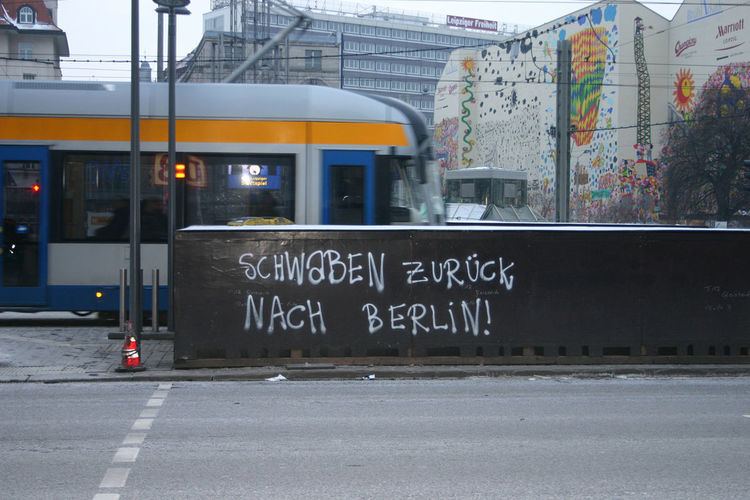 | ||
Schwabenhass (German for hatred against Swabians) is a political slogan about the aversions against the about 300.000 strong Swabian minority in Berlin. In 2013, the so-called spätzlestreit gained nationwide attention.
Contents
Historical background
Schwabenhass occurs in different ethnic groups in Germany. Already neighboring Badener prefer their distance according the notion, we have nothing against Swabians, at least nothing with sustainable remedy effect. Theodor Fontane had Effi Briest say, that already in the 19th century, Swabish neighbors were a reason to start leaving certain neighborhoods in Berlin.
The term Schwob/ Szwab has been used by Poles and Swiss as ethnic slur for all Germans. Similar prejudices applied to the Donauschwaben in Hungary despising everything German.
Role in gentrification
Berlin (as a whole) was not accustomed to gentrification and went through a rather quick modernization process after 1989. Swabians were being deemed as gentrification drivers. „Schwaben“ as a term is being used as a Synonym for all sorts of well-to-do west-German immigrants.
There have been cases of arson. e.g. on expensive buggies and trendy cars. Jan Fleischhauer saw "Schwaben-Hass" as a politically correct variant of xenophobia for left-wing intellectuals hiding otherwise totally unacceptable political positions against foreign infiltration or domination by immigrants.
Prenzlauer Berg slogans included snowclones such as „Schwaben töten“ (Kill Swabians), „Wir sind ein Volk. Und ihr seid ein anderes“ (We're one people. You another) or „Ostberlin wünscht dir eine gute Heimfahrt“ (get home, bon voyage). The police started acting after „Kauft nicht bei Schwab'n“ (don't buy Swabian, a snowclone on a wellknown antisemitic parole) was used as graffiti in Berlin's Rykestrasse.
Thierse controversy
Politician Wolfgang Thierse (SPD) had accused Swabians in Berlin of a lack of adaptive capability and a lack of understanding the 'culture of Berlin'. The notion in a local Berlin newspaper gained nationwide flak. Germans doubt whether Berlin has any (high brow) culture at all, as Berlin 'milieu' stereotypes, based on Heinrich Zille's work, are often working-class-derived. Thierse himself does not any such local background, as a man of letters and catholic immigrant from former Silesia. Cicero magazine tried to describe him as an all-German square "Spießer" due to the controversy. Thierse's use of Überfremdung points against Swabians was harshly criticized, and he faced considerable protest.
During this Berliner Schwabenstreit 2013 various Spaßguerillas turned up, as „Free Schwabylon“, claiming a micronation for Swabian emigrants around Kollwitzplatz, close to Thierses home. New York Times reported about various aspects of the conflict, under the title „Swabian Separatists Fling Spätzle to Make Their Point“.
For later reconciliatory efforts, Thierse received a "Goldene Narrenschelle", an order of Carneval from Vereinigung Schwäbisch-Alemannischer Narrenzünfte (VSAN), an umbrella organization of Swabian–Alemannic Fastnacht.
